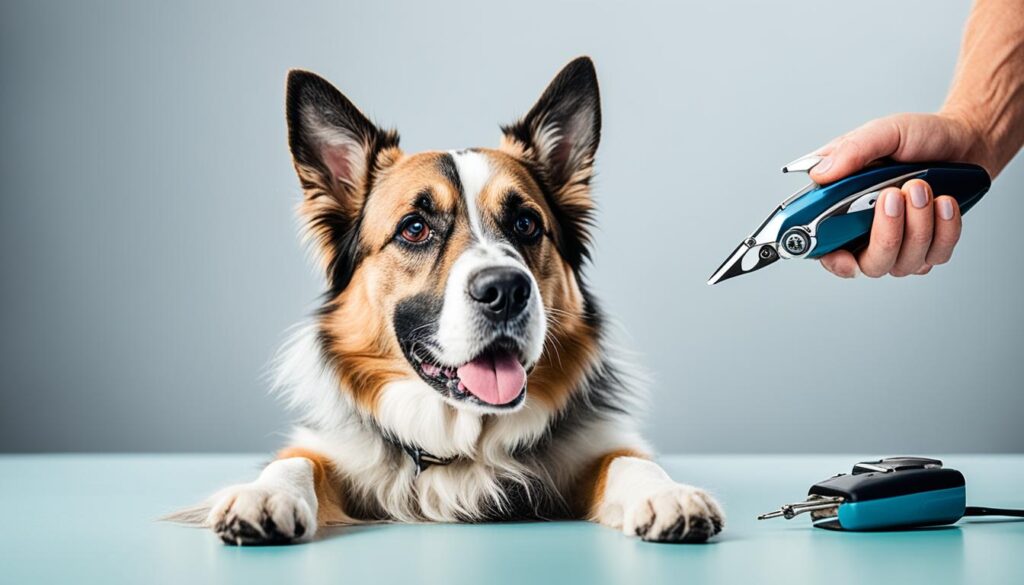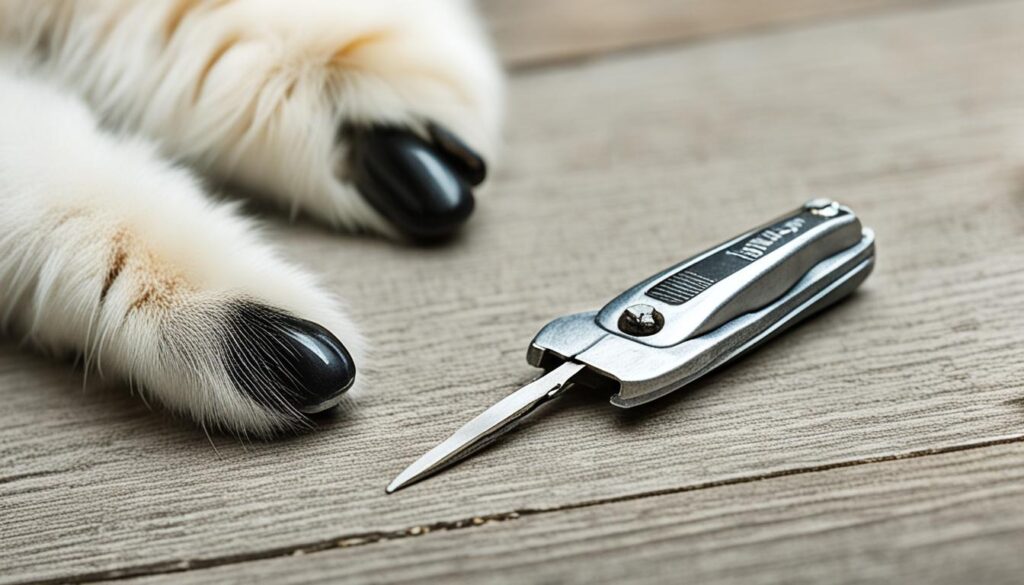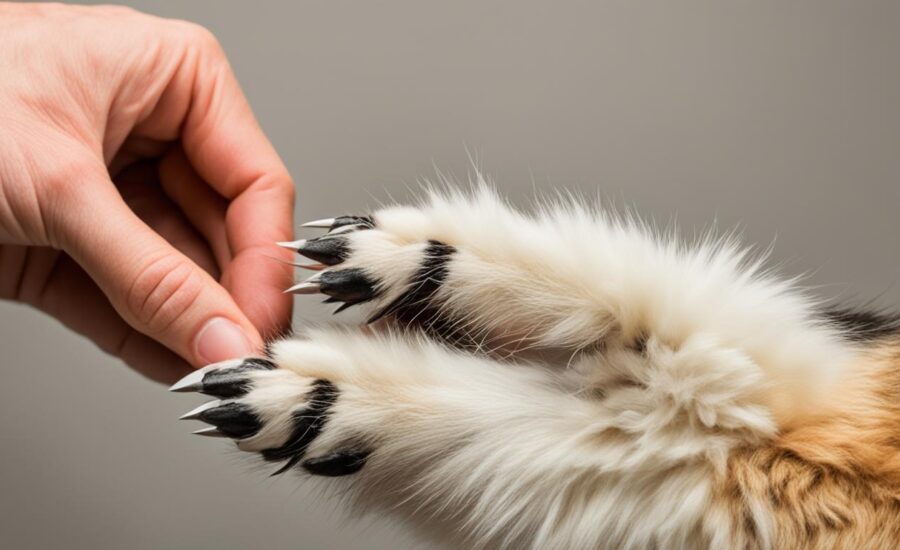Every pet owner feels nervous about nail clipping. Have you thought about a better way to do it? Beyond the squirms and yelps, knowing the right way makes your furry friend’s paws look great. This guide offers Nail clipping tips for pets to keep them safe. It might even make this task fun.
Here, find DIY pet nail clipping advice that mixes science and care. With this advice, you can clip nails without worry. Learn the Dos and Don’ts of Nail Clipping for Dogs and Cats. It’s not just about looks. It’s about keeping your pet happy and healthy, too.
Key Takeaways
- Understanding the importance of pet nail care and the psychological impact it has on your pet.
- Discovering the correct tools and techniques for a gentle, effective nail clipping session.
- Overcoming the anxiety associated with nail clipping to create a positive environment for your pet.
- Empathetic and gradual introductions to nail clipping can lead the way to a smoother grooming experience.
- Recognizing when it’s time to seek professional grooming services to maintain your pet’s paw health.
Understanding the Importance of Pet Nail Care
Pet grooming is more than just a shiny coat. It includes pet nail care best practices crucial for our pets’ health and comfort. Knowing the importance of nail care is key to holistic pet health.
Why Regular Nail Trimming is Essential for Your Pet’s Health
Trimming your pet’s nails regularly is essential. It stops nails from growing too long and curling, which can cause infections and pain. It keeps your pet walking naturally, without harming their joints.
Long nails can change how pets walk and put too much pressure on their joints. This can lead to arthritis. Learning how to trim pet nails safely helps avoid these issues and keeps your pet moving easily.
The Consequences of Neglecting Nail Care in Pets
Ignoring nail care can badly affect your pet. Overgrown nails can make their posture odd and cause foot pain. This can change how your pet acts since moving hurts them.
| Overgrown Nail Impact | Behavioral Signs | Potential Health Risk |
|---|---|---|
| Difficulty in Walking | Reluctance to Play | Joint Stress |
| Nails Growing into Paw Pads | Limping or Favored Paws | Infections |
| Quick Protrusion | Resistance to Paw Handling | Bleeding and Pain |
Knowing pet grooming do’s and don’ts is vital for your pet’s health. Following these practices keeps your pet joyous, healthy, and free from pain. It lets them live an active life.
Preparation is Key: Setting the Stage for Successful Nail Clipping
When you trim your pet’s nails, the right mindset and setting make a big difference. A key tip from a nail trimming guide for dogs and cats is to choose a quiet place. This makes your pet calm and ready to cooperate, not just focus on the clippers.
Selecting the Right Environment for Nail Clipping
Choosing where to groom your pet is crucial, according to pet grooming do’s and don’ts. Pick a spot that is bright and comfy for you and your pet. Your pet should feel at ease in this familiar space during nail trimming.
The Art of Timing: When to Tackle Nail Trimming
The right timing is key in pet grooming. Clip nails when your pet is calm, like after eating or playing. Make it a positive moment with treats and love to keep it stress-free.

- Opt for a quiet time when distractions are minimal.
- Ensure the environment is comfortable and well-lit.
- Gradually introduce the nail clippers to your pet’s routine.
- Reward your pet with treats to create a positive association.
- Pay attention to your pet’s body language and proceed with patience.
Following a nail trimming guide for dogs and cats isn’t just about having tidy nails. It’s also about building trust and comfort with your pet. These pet grooming do’s and don’ts tips mean nail trimming will no longer be a tough task. It’s all about preparation for you and your furry friend.
The Right Tools for the Job: Choosing Nail Clippers
Keeping our pets’ nails trimmed is key to their well-being. Yet, picking the right tool can be tricky. Between guillotine and scissor-type nail clippers, the choice varies with each pet. Both types are crucial for pet paw care essentials when used right.

Guillotine vs. Scissors: Which is Best for Your Pet?
Choosing the best nail trimmer depends on your pet’s size and nail thickness, and how the tool feels in your hand. Starting with the right clipper is the first step to how to trim pet nails safely. Guillotine clippers suit small to medium pets well, making clean cuts quickly. While scissor clippers are better for larger pets with thick nails, giving more control and strength.
Maintaining and Sharpening Your Nail Clipping Tools
Using a dull tool can hurt your pet, causing nails to split or worse. This is why keeping nail clippers sharp is vital professional pet nail trimming tip. Sharp clippers mean smooth, clean cuts, showing pet paw care essentials importance.
| Clipper Type | Best For | Maintenance Tips |
|---|---|---|
| Guillotine | Small to medium-sized pets | Keep the blade sharp; replace if blunt |
| Scissors | Larger pets with thicker nails | Regularly oil for smooth operation |
| Grinder Tools | Pets with anxiety or sensitive to pressure | Clean after each use; check for wear |
The Dos and Don’ts of Nail Clipping for Dogs and Cats
Knowing the pet grooming do’s and don’ts is crucial for your pet’s paw health. A key rule in nail clipping tips for pets is to take your time. Make sure to get your pet used to having their paws touched before starting.
When handling their paws, be gentle. This reduces stress during nail trimming. It’s also vital to choose the right tools for nail clipping. Pick clippers that match your pet’s nail size and thickness.
Giving your pet treats after clipping their nails encourages good behavior. This makes them more cooperative next time. Remember, effective pet nail care best practices focus on both the clipping and making it a positive experience.
| Do | Don’t |
|---|---|
| Acclimate your pet to having their paws handled. | Cut the nails too short, risking cutting into the quick. |
| Use sharp, appropriate clippers for clean cuts. | Continue clipping if your pet shows excessive stress. |
| Reward with treats after nail clipping. | Ignore signs of pain or discomfort in your pet. |
| Clip nails in a well-lit environment to better see the quick. | Neglect to seek professional help if you are unsure. |
If you’re unsure, especially with dark nails where the quick is hard to see, get professional help. This prevents injuries and keeps your pet safe and well.
“When in doubt, pause the trim. There’s no shame in seeking help—it’s a sign of caring and responsible pet ownership.” – A seasoned vet’s nail clipping counsel for your pets.
Step by Step: How to Safely Trim Your Pet’s Nails
Learning to maintain your pet’s nails improves their health. It turns grooming into a time to bond. If you decide to trim your pet’s nails yourself, you’ll need patience and to be careful. By using professional pet nail trimming tips, you and your pet will do great. Here’s a method to keep your pet’s nails short and safe.
Proper Handling Techniques for Secure Clipping
First, handling your pet right is key to safely trim nails. Make sure your pet feels okay before starting. Hold their paw gently yet with enough grip so they feel stable and trust you. If they seem upset, stop. Calm them down before you try again.
Finding the Ideal Angle and Position for Cutting
When trimming your pet’s nails, it’s important to know their nail structure. You should cut at a 45-degree angle to the bottom of the nail. This helps make a smooth cut and keeps your pet comfy. If cutting gets tough, or your pet seems hurt, check your angle and go slow.
If this task feels too hard, ask a pro for help. Professional pet nail trimming tips can be a big help. Having a vet or groomer do it can ease your worries. Always put your pet’s safety and happiness first.
Addressing the Fear: Helping Your Pet Stay Calm During Clipping
Nail maintenance isn’t just about the steps in the Nail trimming guide for dogs and cats. It’s about how our pets feel during it. Knowing they might be scared is key to making it easier. For those doing it themselves, we have tips to help your pet stay calm and willing.
Conditioning Your Pet for Nail Clipping Sessions
To change how your pet views nail clipping, start slow. Touch their paws often, let them hear the clippers, and check their nails without cutting. These actions help prepare them for stress-free grooming.
Adding Positivity to the Grooming Experience
Making nail trimming pleasant is a great tactic from our DIY pet nail clipping advice. Give your pet lots of praise and treats they love. This makes them link nail trimming with fun. Our goal is to make grooming a positive time for both dogs and cats.
Professional Nail Clipping Services: When to Seek Help
Trimming your pet’s nails can be scary for you and your furry friend. In these cases, using professional nail clipping services is a smart choice. Vets and skilled groomers know how to handle pets with care. They can trim nails without causing stress to you or your pet.
Getting help from pros is key for your pet’s paw health. These experts not only trim nails but also teach you how to care for them. They use the right tools and methods to avoid hurting your pet. This keeps your pet clean and builds trust with the groomer.
Professionals can make nail clipping stress-free. Not every pet or owner can handle nail care well. This is why getting professional help is part of being a good pet owner. If nail trimming at home is hard for you or your pet, it’s time to get help from experts.
FAQ
Why is regular nail trimming essential for my pet’s health?
What are the consequences of neglecting my pet’s nail care?
How should I prepare my pet for nail clipping?
How do I know when it’s the best time to trim my pet’s nails?
Should I use guillotine or scissors-style clippers for my pet’s nails?
How do I maintain and sharpen my pet’s nail clipping tools?
What are some do’s and don’ts when it comes to clipping my pet’s nails?
How should I hold my pet when I’m cutting their nails?
What is the ideal angle for cutting my pet’s nails?
How can I help my pet stay calm during nail clipping?
What should I do if I’m not comfortable clipping my pet’s nails?
Source Links
- https://skagitanimalclinic.com/nail-trimming-dos-and-donts/
- https://www.rossmorevethospital.com.au/blog/dos-donts-clipping-dog-nails/
- https://www.vetvoice.com.au/ec/pet-ownership/pet-grooming/

